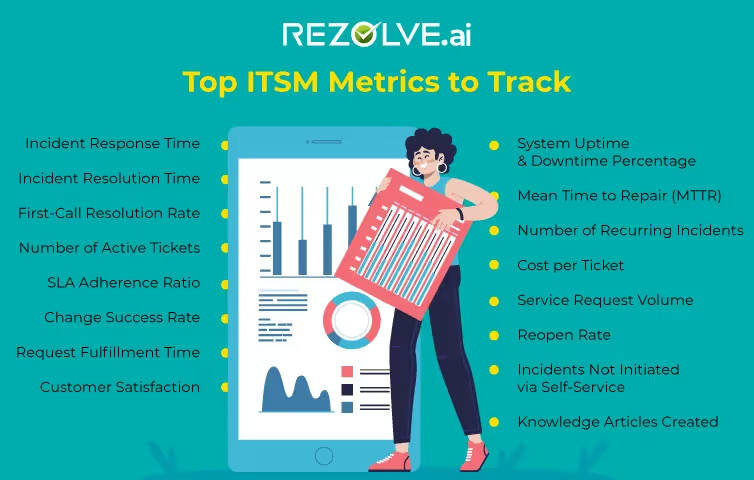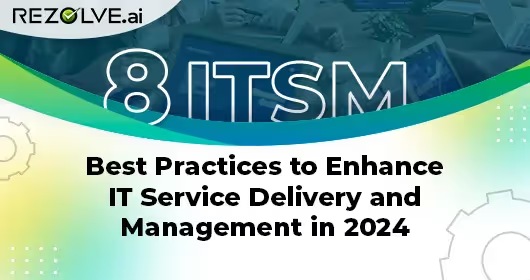Without IT service management (ITSM) principles and practices, IT services can quickly fall apart, leading to chaos and disruption. With the growing cybersecurity risks, operational challenges, and customer satisfaction at stake, ITSM is not just an option. Instead, it is necessary to ensure efficient management of IT services and align them with business goals.
So, today, we will cover 8 ITSM best practices for seamless IT service delivery and exceptional user experience.
8 ITSM best practices
To improve ITSM, you must focus on three key pillars: people, processes, and tools.
Skilled teams drive service excellence through training and collaboration. Well-defined processes ensure consistency and reliability, while purpose-built tools automate tasks and align services with business goals. These elements collectively optimize IT service delivery.
Here are 8 ITSM best practices to ensure reliable IT service management:
1. Define IT Strategy — Keep Business and IT Goals Aligned
IT strategy refers to the detailed roadmap/ plan for aligning IT resources and capabilities with the company's overall business objectives. It includes — your goals, proven strategies (based on existing frameworks such as ITIL), and implementation process.
For instance, a company launches a new product line. The IT strategy could include developing new software applications and upgrading infrastructure to handle increased traffic. Such a strategy enables better resource allocation and enhances efficiency.
To create an effective IT strategy, communicate with key stakeholders across departments to gather insights and end-users to ensure alignment and adoption. Moreover, regularly review and update the IT strategy to align IT efforts with the changing business needs and technological advancements.
2. Automate IT Services — Increase Efficiency and Reduce Errors
Automating IT services involves increasing operational efficiency, reducing manual effort, and minimizing errors by replacing manual interventions with automated solutions.
For instance, using AIOps platforms to detect and diagnose IT incidents, and predict potential issues before they occur automatically. This automation speeds up incident resolution and enhances system reliability.
As a result, you increase operational efficiency and reduce errors, leading to higher accuracy. Also, you free up valuable human resources to focus on more strategic initiatives.
To effectively automate IT services, adopt a hyperautomation approach, which combines various technologies such as artificial intelligence (AI), machine learning (ML), robotic process automation (RPA), and workflow automation.
Start by identifying repetitive tasks and processes, such as server provisioning, software deployment, and incident management. Implement automation tools and platforms that can integrate with your existing IT systems and workflows. Continuously monitor and refine automated processes to ensure they remain effective.
3. Promote a Self-Service Portal — Enable User Independence and Decrease Requests

A self-service portal is a dedicated platform where users can independently access information, request services, and resolve issues without any assistance from IT staff. These platforms provide resources such as knowledge bases, FAQs, and automated service requests. They can be integrated with the company’s ITSM system or into communication platforms like Microsoft Teams, enabling seamless request processing and providing real-time updates.
A self-service portal enables users to resolve IT queries independently and reduces the volume of IT service requests. Users experience faster resolution with immediate access to solutions and support resources, while the IT staff focuses on more complex and strategic tasks. Overall, it contributes to cost savings and user satisfaction by reducing the need for direct IT support.
To implement a successful self-service portal, identify the most common user issues and requests and develop a centralized repository of detailed guides, tutorials, and FAQs. Choose an ITSM tool with a user-friendly portal interface that is easy to navigate and integrates with your IT ecosystem to automate service requests and provide real-time updates.
Promote the portal through internal communications and training sessions to increase user adoption. Moreover, update the knowledge base regularly based on user feedback.
4. Adopt a Knowledge-Centric Approach — Resolve Issues Faster with Shared Information
Adopting a knowledge-centric approach involves creating, sharing, and managing information within an organization to improve IT service delivery with a centralized knowledge base easily accessible to both IT staff and end-users. This includes a centralized hub with detailed troubleshooting guides, how-to articles, and documented solutions to common issues.
So, when users encounter a problem with their software, they can quickly access the knowledge base to find a solution rather than waiting for IT support.
For an effective knowledge base, create a centralized repository of all relevant information and solutions. Encourage IT staff to document their knowledge and experiences and establish a process for regularly updating the knowledge base.
Additionally, implement search functionality and categorize content to make information easily retrievable. Train staff and users on effectively using the knowledge base and promoting its benefits. Regularly review user feedback to identify gaps and improve the quality of the content.

With Rezolve.ai, searchability is not an issue, as its GenAI capabilities converse with the end user to offer personalized solutions within seconds. Finding the right information becomes easier, and advanced analytics ensure database relevancy.
5. Establish KPIs — Track and Improve Your Performance
KPIs are a quantifiable way to evaluate performance, identify areas for improvement, and ensure that IT initiatives align with organizational goals.
Some important IT metrics are average resolution time for service tickets, system uptime percentages, and user satisfaction scores. So, if the average time to resolve a ticket is 48 hours, you might aim to reduce this to 24 hours.

Tracking KPIs regularly allows the company to monitor performance trends and address issues promptly. They provide objective data that helps IT managers make informed decisions and invest in initiatives that drive the most value.
Define clear, measurable, and achievable metrics and engage stakeholders to ensure the selected KPIs align with both IT and business objectives. Implement tools and systems to collect and analyze data related to these KPIs. Communicate the results transparently within the organization for continuous improvement.
Suggested Reads: Essential IT Service Management Metrics
6. Implement an IT Service Catalog — Simplify Access to IT Services
An IT service catalog is a detailed listing where users can find information, request services, and understand service scope and expectations. They can access this catalog through the company’s intranet or a dedicated portal, which streamlines the process of IT support.

Such a catalog provides a clear and organized view of the services offered, making it easier for users to find what they need quickly. Moreover, it sets clear expectations for service availability and performance, enhancing user satisfaction and trust in IT services.
To create an IT service catalog, identify and document all IT services provided. Engage with stakeholders to assess their needs and design a user-friendly catalog that is easily accessible and searchable. Include detailed service descriptions, request procedures, and expected delivery times for each service. Regularly update the catalog to reflect any changes in services or policies.
7. Choose Customizable ITSM Tools — Adapt Solutions to Your Organization’s Needs
Instead of navigating through a rigid off-the-shelf solution, choose a customizable ITSM tool tailored to your specific needs and workflows. By selecting a customizable ITSM tool, such as Rezolve.ai, you can configure workflows, forms, and dashboards to match your specific processes.
To choose the right ITSM tool, assess your organization's specific needs and workflows. For instance, a mid-sized IT company might require a tool that integrates seamlessly with its existing CRM system, supports multi-channel service requests, and provides robust reporting capabilities.

After identifying these key features, evaluate tools that offer extensive customization and integration options, ensuring they meet your unique operational requirements. Also, involve stakeholders in the selection process and test the tool's customization capabilities to ensure it effectively supports your specific workflows.
Train IT staff and end-users to ensure maximum value and adoption of your virtual assistants. Also, regularly review and update the tool's configurations to adapt to evolving business needs and technological advancements.
8. Embrace Change Enablement — Minimize Disruptions and Support Agile Adaptation
Change enablement goes beyond traditional change management by focusing on continuous improvement and proactive stakeholder engagement, ensuring smooth transitions and minimal disruptions.
So, if an IT company plans to roll out a major software upgrade across its organization, with change enablement, it would begin by assessing potential risks and involving stakeholders in the process. It would schedule the upgrade in phases, ensuring each phase is monitored and evaluated before proceeding. Also, based on user feedback, it would refine subsequent phases, minimizing disruption and enhancing user adoption.
Unlike traditional change management, which is reactive, change enablement focuses on proactively identifying trends and optimizing IT services. This leads to smoother transitions, better resource utilization, and higher success rates. Also, involving stakeholders throughout the process ensures minimal resistance, enhancing organizational agility.
To implement change enablement, engage stakeholders early to gather their input and align the change processes with business objectives. Based on this feedback, redesign change management workflows, incorporating continuous improvement and proactive risk assessment.
Implement changes incrementally using agile principles, starting with pilot projects to test and refine processes. Establish KPIs to measure success, such as change success rate and time to implement changes. Regularly review and optimize the change management processes based on feedback and performance data for a culture of continuous improvement and innovation.
Suggested Reads: Change enablement definitive guide
Implement ITSM Best Practices With Rezolve.ai
Improving ITSM is a continuous process, but it is important to understand priorities and avoid disruptions for seamless service delivery.
Rezolve.ai offers a GenAI-powered solution that supports agility without compromising user experience. Its conversational self-service portal, 1000+ integrations, advanced analytics, and out-of-the-box automation capabilities make IT service management a positive experience for end users and IT teams.
FAQs
What is the best framework to use for ITSM?
The best framework for ITSM is ITIL (Information Technology Infrastructure Library). This constantly evolving framework provides best practices for delivering high-quality IT services, ensuring alignment with business needs, and promoting continuous improvement through structured processes and clear guidelines.
What is the difference between ITIL and ITSM?
ITIL provides the guidelines, while ITSM is the practice.
ITIL (Information Technology Infrastructure Library) is a framework of best practices for ITSM. ITSM refers to the overall approach and processes for delivering and managing IT services.
What are the 7 guiding principles of ITSM in ITIL 4?
The seven guiding principles of ITSM in ITIL 4 are:
1) Focus on value
2) Start where you are
3) Progress iteratively with feedback
4) Collaborate and promote visibility
5) Think and work holistically
6) Keep it simple and practical
7) Optimize and automate.





.webp)




.jpg)

.png)








.png)